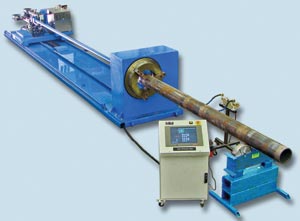
Refined Solution
By Design Engineering Staff
Motion Control Power Transmission ball screwBall screw assemblies key to patent-pending petroleum corrosion technology.
The 21st century has presented a technological shift in oil field drilling as most of the easily accessible oil is tapped and well producers are forced to go deeper to procure highly corrosive sour crude oil (H2S). Sour crude oil is a sulfurous mixture that corrodes the iron in the carbon steel pipe that extracts it. Due to that fact, the petroleum industry has been determined to develop drilling technology that can overcome these corrosive effects to produce oil.

In an effort to provide protection from pipeline failure and allow for oil production in new deep water sour oil fields, leading custom automated and robotic equipment manufacturer ARC Specialties, Inc. has developed a new cladding technology that controls this corrosion to safely extract and process sour crude. The KLADARC advanced TriPulse Hot Wire Gas Tungsten Arc Welding (GTWA) system leverages oscillation welding to deposit a metallurgically clad two-layer corrosion-resistant alloy overlay (nominal thickness of 3.5 mm and guaranteeing the 3.0 mm minimum thickness) on clad pipe up to 20 feet in length and inside diameters up to 30 inches. Ultimately, this patent-pending technology reduces oxide inclusions and iron dilution in the cladding process – thus, mitigating the corrosive effects of H2S.
Ball Screws Key to Oscillation
Paramount to this 5-axis cladding machine’s advancement is the capability to oscillate the arc inside the pipe. This crucial element of oscillation in the process is driven by ball screws manufactured by Nook Industries Precision Screw Group as part of its Power-Trac line of precision ball screw assemblies. The company’s precision-rolled ball screw, with a double bearing support, provided a means of converting rotary motion to linear motion on the dual-torch oscillation axis (X & Y) of the machine .
Ultimately, the dual-torch oscillation simultaneously overlays two layers of CRA onto the pipe’s inner surface and provides a molten “puddle” with longer residence time to bond and eliminate common problems of overlay welding (i.e. leaving holes that penetrate through the overlay layer and thereby expose the outer steel pipe to corrosive sour crude.)
